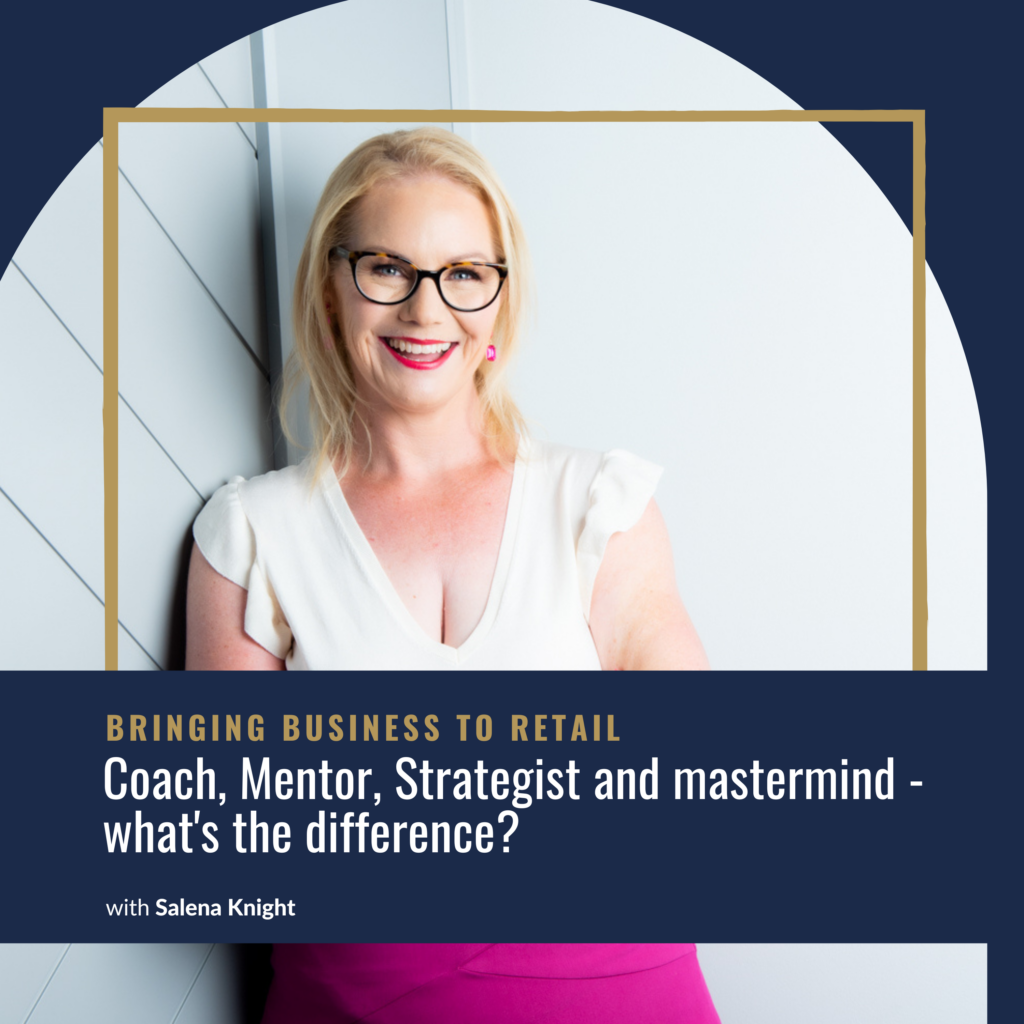
Would you let an ads manager spend thousands of dollars every month, even though you’re not getting any new customers or sales?
How about having to fire a friend or family member, because they’re just not what you need to move you to the next level?
Or, would you let a poor-performing employee, bankrupt your business?
Believe it or not, these are just 3 scenarios I’ve encountered with retail & ecom business owners over the last couple of weeks, that could potentially bankrupt the business.
But even having the threat of going bankrupt hanging over your head, isn’t always been to push a business owner to make a decision.
So it got me thinking.
If bankrupting your business and losing everything that you’ve worked so hard for isn’t enough of a motivator, what is?
Join me as I walk you through a real-life scenario of what happens when you make this hiring mistake, plus the advice I gave and of course the happily-ever-after (or is it?).
———
Common scenarios that could potentially bankrupt a business. 0:02
A furniture store owner struggling with work-life balance and financial difficulties. 3:11
Marketing and inventory management for a struggling business. 8:32
Business constraints and potential solutions for a struggling fashion retailer. 12:31
Poor operations management in a business, leading to low sales and aged inventory. 17:25
Improving business operations through delegation and process updates. 21:52
Managing an underperforming employee in a small business. 27:21
LISTEN NOW on The Bringing Business To Retail Podcast
0:00:03 Salena Knight: Hey there, and welcome to the bringing business to retail podcast. If you’re looking to get more sales, more customers, master your marketing, and ultimately take control of your retail or e commerce business, then you’re in the right place. I’m Selena Knight, a retail growth strategist and multi award winning store owner whose superpower is uncovering exactly what your business requires to move to the next level.
0:00:33 Salena Knight: I’ll provide you with the strategies, the tools, and the insight you need to scale your store. All you need to do is take action. Ready to get started?
0:00:51 Salena Knight: Hey there, and welcome to today’s episode of the bringing business to retail podcast. Thank you so much for joining me today. And I want to let you into a little bit of a behind the scenes today. So let me start by asking you a question. Would you let an ads manager spend thousands of dollars every single month, even though they weren’t bringing you in any new sales or new customers? How about having to fire a friend or a family member because they’re just not what you need to move you and your business to the next level?
0:01:27 Salena Knight: Or would you let a poor performing employee bankrupt your business? Believe it or not, these are just three scenarios that I have encountered with retail and e commerce business owners over the last couple of weeks. These are situations that could potentially bankrupt the business. But even that threat of going bankrupt hasn’t always been enough to push them into making a hard decision. So it got me thinking, if bankrupting your business and losing everything that you have worked so hard for isn’t enough of a driver, what is?
0:02:06 Salena Knight: Now you might be thinking when it comes to those scenarios. I would never let myself get into a situation like that, but I want you to think about it, because I believe that those three scenarios are those times in life when what you think you would do and what you do in the moment can be very, very different because these business owners never thought they would get themselves into this situation.
0:02:34 Salena Knight: And conversely, you ask them if, well, I asked them if they had put this scenario in front of somebody else, would they have made a different decision? So without giving too much away today, I want to walk you through what I see as very common scenarios and give you the advice that I gave them. So if you find yourself in this position, hopefully not. Or if a business friend comes to you with a very similar problem, you’ve got some advice in your back pocket, a bit of a what would sell? Say, let me give you the background of our somewhat fictional business. Now, this is a real business. But of course, I have changed the name and the kind of type of the store to protect the people who are inside of our programs. So this business is a furniture store in Beverly Hills, Los Angeles.
0:03:26 Salena Knight: The owner, let’s call her Brooke. So Brooke has a furniture store in Beverly Hills. And the fact that it’s in Beverly Hills, if you’re not american or if you don’t know american culture, Beverly Hills is a very upmarket area. And so this tells you that the clientele that Brooke and her business are attracting are going to be people who have money to spend attached to the furniture store. So located within the furniture store, it is a massive retail premises, is a property styling business.
0:03:59 Salena Knight: Now, despite being in business for over ten years, when I had the conversation with Brooke, she told me that the business was only doing very low seven figures. Now, this was a red flag to me straight away. I mean, here you have an established business, more than ten years, doing interior design, or, sorry, interior property styling, that we would call it. Yes, I think that’s the property, the property styling business, where you come in interior design, property styling and a furniture, very particular furniture store.
0:04:35 Salena Knight: So the furniture that Brooke catered to was some one off pieces, some antiques, some obviously products that were more mainstream, but overall, a very high profile vibe and a very classic mix of products. Now, the products were expensive, and so this is where I was confused, because, first of all, ten years in business, followed by a very high end clientele where spending 1015, $20,000 on a sofa is the norm, something wasn’t adding up.
0:05:11 Salena Knight: In fact, after a little bit of digging, it turned out that the styling, the design side of the business, was the only thing keeping the furniture store, in fact, the whole business, afloat. So that all of a sudden, for me, was like something that we needed to investigate now a little bit more about the business. So I’ve been in business ten years, two sides of the business, around ten staff, including an operations manager, and sitting at that low six figures.
0:05:41 Salena Knight: But Brooke is exhausted. Sales have dropped, there are less customers in the door. And Brooke gets to the store at between seven and 08:00 a.m. i, even though the store doesn’t open until 10:00 a.m. and she leaves around about eight or 09:00 p.m. even though the store closes at six. So the store is open ten till six. And Brooke is there anywhere from 07:00 a.m. in the morning all the way through to 09:00 p.m.
0:06:08 Salena Knight: so what’s that? An extra four to six working hours when Brooke should be working on the business when the store is closed, when there are no customers, when there are no staff. This is the time that she has to be working on the business. Brooke also has a toddler at home. Now, you and I both know if you’ve got kids, toddlers are hard work. They, in and of themselves, are exhausting. And on top of that, Brooke’s husband works a high profile corporate job that is extremely stressful.
0:06:37 Salena Knight: Now, it is no wonder that Brooke is exhausted. Business, family, husband with a high profile corporate job that comes home stressed. He is suffering. The minute that he walks in the door, the toddler is crying. She has ten staff, she has two sides of the business, and she is one of the designers. Brooke is wrung out. She knows that she is working too much. She feels guilty. It’s affecting her marriage.
0:07:06 Salena Knight: Her mental health is suffering, and she is literally at breaking point. And worse still, Brooke doesn’t even know if things can change. But she knows that she has to do something before her life literally implodes. Now, honestly, these stories break my heart, because we do not go into business to feel like that. We do not go into business to be trapped by our business, to ruin our marriages, to feel guilty, to be so wrung out. You don’t even know what to do when you get up in the morning, so all you do is work more.
0:07:44 Salena Knight: That is not why we go into business. And unfortunately, I see this happening all too often, and I don’t want it to happen to you. So that is why I’m sharing this story. Let’s get into the money side of things. Even though Brooke pays herself a small wage, there are less customers coming in, less sales overall, and especially in the shop side of things. So the money that’s coming in is coming in from the design, styling side of the business. Business.
0:08:11 Salena Knight: And that is what Brooke is doing. In amongst everything else. She is one of the stylists. The only money that’s coming in is coming from that side, which means she feels like if she works more hours, she will make more money. And she’s at the stage where if things don’t improve quickly, the business will probably go bankrupt. There’s no money left in the bank. So what is Brooke to do? Here’s where most people get it wrong. When it comes to getting off that exhausted and desperate treadmill, they look at the external factors first. They look at the economy.
0:08:43 Salena Knight: Sure, there is reduced spending. Summer holidays, there’s nobody around. Everybody’s gone on holidays. They’re looking for anything that is easy to blame and that is where most business owners stop with the blame. They stay stuck and they whinge about everything and three years later they are completely burnt out, even though they have what looks like to everybody else on the outside, a successful seven or eight figure business.
0:09:11 Salena Knight: But there are limited, if any, profits. And the business owner themselves is spending all of their time worrying about the business. Or what I also find is they’ve completely checked out, they have moved on, they don’t want anything to do with it, because the minute that they think about the business, it just stresses them out. So generally what happens at this point is they go on for a little bit longer, or unfortunately, they go on until they break down or their partner calls them out and says, this is not on anymore, this is not a good place to be.
0:09:45 Salena Knight: Maybe you have found yourself in that position before, or you could see that it could happen, or you’ve read about it in a Facebook group, or, you know, a business owner that has been through this exact same scenario. Well, listen up, because you can totally avoid this. Okay, so the next default place to go when people are trying to break down what they should work on is marketing. And I’ll be the first one to say, when people tell me that they have less customers and less sales, the first question I ask is, what are you doing to market your business?
0:10:18 Salena Knight: Generally, when sales and customers are down, that is the first place to look. What are you doing to get people to know that you exist and to want what you sell? That is what the marketing pillar is all about. Now, in Brooke’s case, she was paying an agency a small amount per month to do Google Ads. And by small, it was a couple of have to say for a seven figure business, a couple of thousands of dollars a month on ads isn’t enough.
0:10:45 Salena Knight: But that’s beside the point. But the simple fact was the customers had dropped, the sales had dropped in both the styling business and inside of the shop. And the agency had told Brooke that she just needed to spend more money. But of course, Brooke is reluctant. She’s already spending thousands and she’s not seeing results. So, ads agency not living up to their side of the deal. Now remember, Brooke has ten staff, including an operations manager.
0:11:12 Salena Knight: Now, when I dug a little bit deeper into the marketing side of things, Brooke told me that if the business was lucky, she would send out one email a month. She was just too exhausted to think of anything to write, let alone sit down and create a marketing plan. And then I go ahead and implement it. Plus, if she was honest and it took a little bit of digging to find this out. She didn’t know if she could cope if there was a huge influx of customers because, remember, she was the lead stylist.
0:11:43 Salena Knight: Marketing. Hmm. Next, let’s look at her inventory. That’s probably the next place I usually go when I’m breaking down a business. Her inventory had around $600,000 of aged stock, hundreds of thousands of dollars of cash flow tied up. That’s around half of their annual turnover. So surely just selling off the inventory would fix all of the problems, right? Sal, you are always saying, get a cash flow boost. More cash solves problems. Cash gives us options.
0:12:11 Salena Knight: Cash will get a brand new stock and it will bring the customers back in. Is that the answer? When it feels like there are so many things to address, it can be difficult to know where to start. So here’s how we break it down inside of our five X framework. And we broke it down from Brooke. First of all, we did an audit of the business and you just heard the outcomes of some of those areas. And then what we do is identify what is the one problem. It is the first question that we ask when we are implementing a plan. What is the one problem that if we solved it, a whole bunch of other problems would just disappear.
0:12:51 Salena Knight: So let’s work through Brooke’s scenario. The external factors, things like the fact that people are spending less and it’s summer holidays, you generally can’t change those. So that’s not something that we’re going to work on. Marketing, should we spend more money? Should we give the ads agency more money? No. If they’re not already getting you results, giving them more money is not going to put you in a better place.
0:13:14 Salena Knight: What we could do is put KPI’s in place or fire them and hire a new agency to get more people in the door. But Brooke is already exhausted managing the ten people that she has and profits have dropped. At this point, marketing is actually going to put more stress on Brooke. I know you think when I say do more marketing, it’s the answer. I give you all five pillars and I always say, what is the one thing that if you just fix that obstacle, if you fix that problem, a lot of problems would just disappear. And for some of you, it is marketing, but not always. And this is what I’m trying to walk you through.
0:13:55 Salena Knight: Sometimes the thing you think is the problem, or the outsider who doesn’t know what is going on in your business, you ask a question in a Facebook book, Facebook group, and people like you do more marketing, spend more money put KPI’s on your agency. If you’re in a situation like Brooke, spending more money and hiring a new agency isn’t going to solve your problems. So maybe it’s the cash. I mean, Brooke doesn’t have an awful lot of money. Maybe if she just paid herself some more, she’d be in a better position. Maybe we should just have a big sale and get rid of that age stock.
0:14:28 Salena Knight: That will bring in more money and all the problems would be solved. But does it, though? I mean, again, cash flow boost is one of the first places that we go when we’re looking at auditing a business, because a lot of times a little bit more cash does free up a lot of problems. But putting on a big sale at this level, when you have that much stock, when you have $600,000 of aged inventory, you have to go to a lot of effort to bring in the customers, and a lot of effort means a lot of input.
0:15:03 Salena Knight: So then we had to work backwards and say, does Brooke even have the mental bandwidth to be able to cope with that? And let’s say the sale works and Brooke has $100,000 in the bank. What does she do with it? I mean, she’s already got ten staff, so she shouldn’t have a staffing problem. And marketing we’ve already worked out isn’t necessarily going to fix the problem because it all comes back to that one question.
0:15:28 Salena Knight: What is the one thing, the biggest constraint in the business? That right now, if we fixed it, a bunch of other problems would just disappear. Now, if you haven’t figured it out yet, it’s Brooke. Brooke’s exhaustion is stopping everything. Is the answer just to get rid of Brooke? Well, eventually, yes. But at this point, the business is not in a position for her to step back. Remember I said that Brooke had an operations manager.
0:15:57 Salena Knight: Now, personally, I’m going to say, I don’t think you need an operations manager when you are at just over a million dollars, especially when there is no store manager and no styling business manager. All of that was Brooke. And so I asked her, is the operations manager in charge of both sides of the business? And she said, no, she’s just in charge of the store. All right, so they’re just a store manager.
0:16:24 Salena Knight: Brooke was like, no, no, no. They’re an operations manager because they look after the store. They look after all the marketing, they look after the logistics of getting the product from the styling side of the business. They get the product out to the customers. Things like furniture have to be organized with a logistics company. They look after staffing and they look after inventory. I was like, okay, fair enough.
0:16:48 Salena Knight: I can see how that would work. It’s more than just a store manager’s role, just a little bit more than a store manager’s role. Let’s just back up. The Ops manager is in charge of marketing, but there is no marketing being done in house and the agency isn’t getting any results. In fact, any emails going out are being written by Brooke. There is no marketing plan and we all know that if you stop marketing, you are going to get less customers in the door and less sales as a result.
0:17:19 Salena Knight: Now the operations manager is also in charge of staffing, but wasn’t doing in the rosters. There were too many staff on the floor. When there were no customers to serve, there were no KPI’s for the team and there was no reporting being done. In fact, the operations manager, I discovered, was only working four days a week in store from around eleven till two because the operations manager had a kid that had to be dropped off and picked up at school and they were being paid $75,000 a year.
0:17:54 Salena Knight: Even worse, I discovered accidentally that they were taking days off, paid days off every single month because they are on a salary. They were just going to a hens party for a long weekend or their family was in town, so they weren’t going to come into the store this week. They would work from home. So in short, if the operations manager was actually doing what the operations manager’s job was, Brooke could work less hours, there would be marketing, Brooke wouldn’t be stretched thin, she would have time to work as the lead designer.
0:18:31 Salena Knight: The inventory wouldn’t be aged and if it was, there would be a plan in place to be able to move it. The sales team would be engaged because they would have customers to serve and KPI’s to meet. And as it was, the culture was going down the toilet because the staff were just sitting around on their phones because there weren’t many customers to serve. There was no one leading them and no one holding them accountable other than Brooke. And yet, the operations manager was getting paid $75,000 a year and Brooke sometimes wasn’t paying herself at all.
0:19:03 Salena Knight: Now it is easy to judge from the outside and say, I would never let that happen. But when you are in the thick of it and this happens over the years, it’s just a little thing upon a little thing upon a little thing. Someone taking a long weekend to go to a hens party, sure, that’s fine. And then they start to just build up and build up. And when there is so much on top of you, it can be difficult to pinpoint the problem.
0:19:29 Salena Knight: So this is not about laying blame on the CEO and owner of the business. This is identifying the problem so we can fix it so that we can put a solution in place where the business starts to work for you. So, digging a little bit deeper, I discovered the operations manager was Brooke’s best friend since high school. 25 years they had been friends. Now, this is a really tricky situation. Am I right? So what’s next? Well, I’ll tell you what I did with Brooke.
0:20:05 Salena Knight: We asked that question, what is the biggest constraint in the business? We worked through all those scenarios, the marketing, the sales. We found that if the operations manager was just doing the operation, operations manager tasks, then a lot of those problems would just disappear. So now we’ve worked out the constraint. The constraint is the operations manager just not doing their job. So what do you do with an underperforming employee, even if it is your best friend? Well, I would love to say, first, don’t mix friends and business, because I can tell you that I have seen this version of this scenario play out 20, 30, 40 times in business, and very rarely does it end well.
0:20:46 Salena Knight: So next is about assessing the role. So quite often in this situation, what I find is the role actually has too much in it. No one person can do all of the things in the time that they have allotted. And so if that’s the case, it’s quite simply just pulling the role apart and then looking at what are those key things that the person has their strengths in and that they can undertake, and then what are maybe some things that we can cut out or we can outsource or we can delegate. And so we went back through the operation manager’s position description, and in this case, they were working a full. Well, the job required a full 40 hours week.
0:21:27 Salena Knight: And the operations manager did have a lot of experience in marketing and those other management tasks that were inside of the role, they had been doing them over the years. So they had a lot of experience. Just a bit of a side note. If the answer had been no and they couldn’t do all of it, like I said, it’s breaking that down and then working out what the role requires. And then you would have to go back through things like remuneration packages and hours. And the operations manager position may become redundant and is replaced with a store manager and a design manager, for example. But in this case, the operations manager had the experience and they had the time to be able to take on their role or delegate some of those things and just manage the in house staff to take those tasks over. And we did that by sitting down and working out what would a work week look like on Mondays, the logistics side of things. All the deliveries that had to go out would be organized, for example.
0:22:33 Salena Knight: And then on Tuesdays was a marketing day and then Wednesday, Thursday, Friday was the other roles that they had to look after. So when you sit down and you plan out the week again, you’re looking to see are there enough hours for this person to actually achieve their goals to hit their KPI’s. So in this case, yes, there was. And we worked out what that week would look like. We worked it in. So when Brooke was available to do things like have the weekly marketing meeting and any key people that they needed, like suppliers, all of that was worked out.
0:23:06 Salena Knight: Next it was time for the hard conversation. So at this point it was just Brooke and I who had worked this stuff out. Now it is time to talk to the best friend operations manager. And in this case, Brooke had to get. The key thing that Brooke had to do was to get her team member, the ops manager, back in the office five days a week. Working an eight hour day sounds really easy but this is really hard when you have put those flexibilities in place and some of this conversation may not resonate with you, but this part in and of itself might do. If you have someone like an ecommerce manager or a marketing manager or an operations manager who post Covid has been okay working from home, but things have changed now maybe it is time to sit down and work out. Do you need them back in the business?
0:23:58 Salena Knight: And in Brooks case she needed her operations manager in house because they were the store manager, they were in charge of training and KPI’s and reporting, all those kinds of things. So this can be a really hard conversation to have if you’ve let things slide into, in Brooke’s case, just to be like a handful of face to face hours a week. Next was putting some really clear KPI’s in place. How many emails would the Ops manager have to be sending each month? How much money would they make from email marketing?
0:24:29 Salena Knight: What promotions would they run each month? How many promotions? Who was going to be in contact with the suppliers? Was that her or was it Brooke? What reports needed to be done every day, every week, every month for the business to continue to run and to be ready for those weekly meetings that Brooke had put in place when she sat down and worked out the workweek would daily stand up meetings work? How long would they go for? The other thing that Brooke was really, this all really brought up for Brooke is they didn’t have very good processes. They had a huge process book, but the processes weren’t relevant or they hadn’t been updated.
0:25:08 Salena Knight: So one of the things Brooke wanted the operations manager to work on, which was actually in their job description, was the creation of one process a week or the updating of one process a week. So over a year, that’s 50 processes that, you know, are up to date or have been created. The operations manager also needed to train staff and put KPI’s in place for them. So, as you can see, some of you may already be breathing a sigh of relief and just thinking, oh, my God, can I have one of those? And the answer is yes.
0:25:38 Salena Knight: For most of you, a store manager, or potentially even an e comm manager would take a lot of this stuff off your plate. And just like Brooke, if you took all of that off your plate, it would free up Brooke’s time to spend networking, which in an area like Beverly Hills was a huge part of her referral base for the property styling business. It would allow Brooke to go and source new products to go to trade fairs. They had their own product that they wanted to be marketing, but she never had a chance to go and work with a manufacturer to create it.
0:26:13 Salena Knight: It would give Brooke time to review the numbers and see what they needed to change in the business. Should they be spending more money on marketing or less money on marketing? All of these things would bring in more sales, more customers, and they would increase profit margins and Brooke would be able to spend time with her husband and her toddler. So, can you see now how being able to properly, properly, properly diagnose the biggest constraint in your business can sometimes have a dramatic and sometimes almost instantaneous improvement.
0:26:49 Salena Knight: I mean, even just having the operations manager back in the office where Brooke could have conversations with her and see what she was doing, that would be a dramatic reduction in Brooke’s mental and physical load. Sometimes throwing more money at a problem isn’t the solution. Quite often the answer is just about, you know, just like Brooke pulling up your big girl pants and stepping into the uncomfortable to save this thing that you have worked so hard, hard to build. And you might be thinking, well, what happened to Brooke and her business after the long conversations with the operations managers were had and the KPI’s were put in place?
0:27:27 Salena Knight: It’s just a reminder that if things didn’t get better fast for Brooke, then there was a pretty good chance that the business would probably go bankrupt. So surely if things were that bad, if she was on the brink of losing everything that she had built for ten years just by holding someone accountable, surely you would do everything you could, you would start right this second. Well, sometimes, yes, sometimes the story works out and the operations manager steps up and things go from strength to strength and that business will two x five x ten x in a really short period of time.
0:28:05 Salena Knight: Because without all that other stuff in their head, the business owner can focus on growth. In this case, the accountability for the operations manager was actually met with a lot of resistance because of course, operations manager had the cushiest job ever. Turn up when you want, do what you want and get paid $75,000 a year. I mean, just getting the operations manager to agree to turn up to work five days a week became a huge issue for Brooke.
0:28:36 Salena Knight: Despite constant agreements to be in the office, the operations manager was constantly leaving early or they were sick or there were childcare emergencies and there was always promises to catch up from home. But that just didn’t happen. And a lot of the stuff brooke needed, Brooke needed them there. Managing the in store experience. Now, most business owners in this scenario would just performance manage the person out of. And actually that’s quite easy to do. And what I find in this situation is if you found yourself in a position where you have an underperforming employee, you can performance manage them up.
0:29:17 Salena Knight: You put the KPI’s in place and you leave it up to them. Sometimes you will end up with the best team ever. They have just been looking for someone to put those boundaries in place, to put the goals in place and give them something to work towards. Other times, not so much. They don’t like their style being cramped, they don’t like having to work for their money and they just leave. In this situation, we had to do performance management because the person was on salary.
0:29:44 Salena Knight: Having the KPI’s meant quite clearly that if the person wasn’t doing their job, they could then be fired. But I am really sad to say that in this case, because the operations manager was Brooke’s best friend from school, she just didn’t feel that she could hold the person accountable. Things would be great for a couple of days when the operations manager turned up and Brooke would get so excited and then next week nothing would get done.
0:30:09 Salena Knight: Last I heard, Brooke had decided that this was all too much and she was just going to close down the business. That breaks my heart and it is proof that you can give somebody all the strategy in the world. But at the end of the day, it’s not my business, it’s not my money, it’s not my life to make those decisions. It’s Brooke’s, it’s yours. It’s the person who comes to you for advice. And it can be heartbreaking because, you know, they put so much time and effort into the business and money, all to just let it go because it got too much.
0:30:44 Salena Knight: And I can totally appreciate that. For Brooke, her financial health, her mental health and her family was more important. She felt like it was the only option. But I can also see how this could have all been avoided. Now, what I’m hoping that you’ve gotten from this real life example is that you can put resources in the wrong place. And what it can end up doing is fueling the breakdown. In Brooke’s case, there were several areas where the business needed to improve.
0:31:14 Salena Knight: And if Brooke had gone to the marketing agency and got them to drive more traffic to the store, they would have given her marketing advice because that’s their job. And this is what happens when we search for advice. The people who have their own interests and not necessarily in a bad way, they’re going to give you the advice that works for them. So if you go to an SEO company, they’re going to tell you you need SEO help.
0:31:37 Salena Knight: A marketing company is going to tell you you need marketing help. That’s their job. Most experts are going to be biased because it’s not in their scope of work to look at a business holistically. That’s the job of the CEO, that’s your job. But without fixing that choke point, without getting to the bottom of that question, what is the one thing that if I could just sort all this out, a whole bunch of problems would just disappear.
0:32:02 Salena Knight: And putting the time and money and effort into that, rather than other solutions, will propel your business forward. But if you don’t ask that questions, if you put the effort, if you put the money, if you put all of your resources into something, that is not the biggest problem. What can actually happen is it can send your business backwards instead of setting it up for success. And in some cases it can even bankrupt your business.
0:32:29 Salena Knight: Don’t let that happen, my friends. What is the one thing that if you just fix that problem, a whole bunch of other things would just disappear? I hope that you have enjoyed, well, maybe not enjoyed today’s lesson. I hope you have taken a lot away from today’s podcast because this is a real life scenario and it could have gone two very different ways. It could have gone to a ten x 1020, $30 million business, or in this case, it didn’t go that way.
0:33:01 Salena Knight: Sometimes what we do is the best for us at the time and the place that we are. But if you have someone who is in that scenario, or if you maybe are finding yourself slipping to that kind of edge of having that underperforming employee know that actually it’s a really simple fix. It might take you a little bit of time, but you’ve got to pull up your big girl pants or your big boy pants or your big any pants.
0:33:28 Salena Knight: And know that if you really want this thing to work for you, then you are the person who is in charge of the ship. Alrighty, my friends, thank you so much for listening to today’s episode. I can’t wait to talk to you next week. Same time, same place.
0:33:48 Salena Knight: So that’s a wrap. I’d love to hear what insight you’ve gotten from this episode and how you’re going to put it into action. If you’re a social kind of person, follow me, Heselena Knight, and make sure to leave a comment and I let me know. And if this episode made you think a little bit differently or gave you some inspiration, or perhaps gave you the kick that you needed to take action, then please take a couple of minutes to leave me a review on your platform of choice.
0:34:19 Salena Knight: Because the more reviews the show gets, the more independent retail and e commerce stores just like yours that we can help to scale. And when that happens, it’s a win for you, a win for your community, and a win for your customers. I’ll see you on the next episode.
Share this episode
Watch The Video











